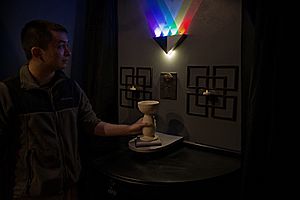Escape room facts for kids
An escape room, also known as an escape game, is a game in which a team of players cooperatively discover clues, solve puzzles, and accomplish tasks in one or more rooms in order to progress and accomplish a specific goal in a limited amount of time. The goal is often to escape from the site of the game.
Escape rooms became popular in North America, Europe and East Asia in the 2010s. Permanent escape rooms in fixed locations were first opened in Asia and followed later in Hungary, Serbia, Australia, New Zealand, Russia and South America.
Contents
Definition
Escape rooms or Escape boxes are inspired by "escape-the-room"–style video games. This is also the likely source of their name. It is also referred to as Room Escape, Escape Game, Exit Game and Live Escape.
In spite of the name, escaping a room may not be the main goal for the players, nor is the game necessarily confined to a single room.
Game play overview
The participants in an escape room normally play as a cooperative team ranging anywhere between two and ten players. Games are set in a variety of fictional locations, such as prison cells, dungeons, and space stations. The player's goals and challenges they encounter usually follow the theme of the room.
The game begins with a brief introduction to the rules of the game and how to win. This can be delivered in the form of video, audio, or a gamemaster.
After this, the clock is started and players have 45 to 60 minutes to complete the game. During this time, players explore, find clues, and solve puzzles that allow them to progress further in the game. Challenges in an escape room lean more to mental than physical, and it is not necessary to be physically fit or dextrous.
If a team gets stuck, there is a mechanism in place for the players to ask for hints. These hints can be delivered using paper, video, audio, or a gamemaster in the room.
If the players are unable to solve the game's puzzles within a time limit, the team is typically notified by the game's operator and escorted out of the room.
If players achieve the goal within the time limit, they win the game. Sometimes, teams with fast times are placed on a leaderboard. Most escape rooms have clues and codes to unlock other areas.
Game design
Puzzle solving
Escape rooms test the problem-solving, lateral thinking ("thinking outside the box"), and teamwork skills of its participants by providing a variety of puzzles and challenges that unlock access to new areas in the game when solved. Escape room puzzles could include word, number, and symbol puzzles such as substitution cyphers, riddles, crosswords, Sudoku, word search, and mathematics; puzzles involving physical objects such as jigsaw puzzle, matchstick puzzle, and chess; and physical activity such as searching for a hidden physical object, assembling an object, navigating mazes, or undoing a rope knot. An example of an escape room puzzle would be placing a code on a spinning fan so that it can only be read using a stroboscope in the dark. Therefore, players have to turn off the light, turn on the stroboscope, notice the spinning fan, read the code and apply it later in the game.
Stories and themes
Escape rooms usually have a story line or theme (depending on the style of the game). Common themes and story lines often found in escape rooms include:
- Airplane
- Carnival
- Christmas & Santa
- Detective/Police/Crime
- Dream
- Heist / Thieves
- Historical
- Library
- Military
- Magic
- Music
- Office
- Pirate
- Prison
- Science
- Sherlock
- Space
- Spy
- Supernatural
- Tomb / ancient civilization
- Vampire
- Western
- Zombie
Evolution
Early games consisted mainly of puzzles that were solved with paper and pencil. Some versions are digital or printable only. As Escape Rooms progressed physical locks were introduced that could be opened by finding combinations, hidden keys and codes using objects found in the rooms. These ideas have evolved to include automation technology, immersive decoration and more elaborate storylines to enhance the visitor experience, make puzzles more interactive, and to create an experience that is more theatrical and atmospheric.
The development of the new device as head-mounted display allows complement or even replace modern approaches to entertainment in the field of Escape Rooms. Multiplayer VR game ability can turn old school designed Escape Rooms into a new wave of Escape Games at virtual reality with big themes variety of locations and styles. Developers of VR Escape Rooms include Ubisoft, Exit, VR Cave, ARVI VR, and Escape VR.
See also
 In Spanish: Escape room para niños
In Spanish: Escape room para niños



